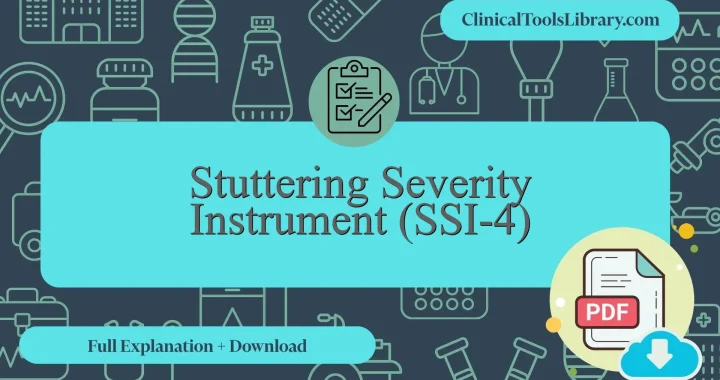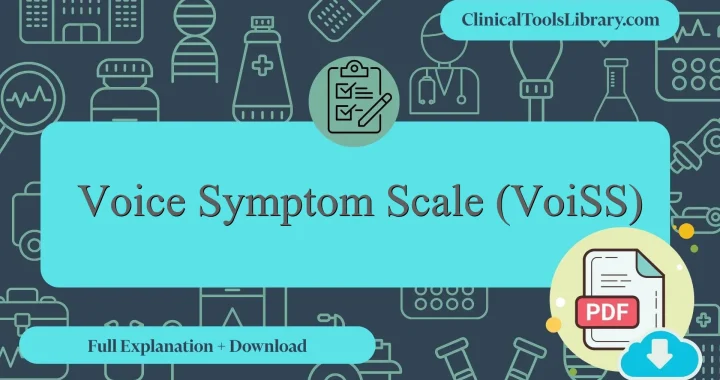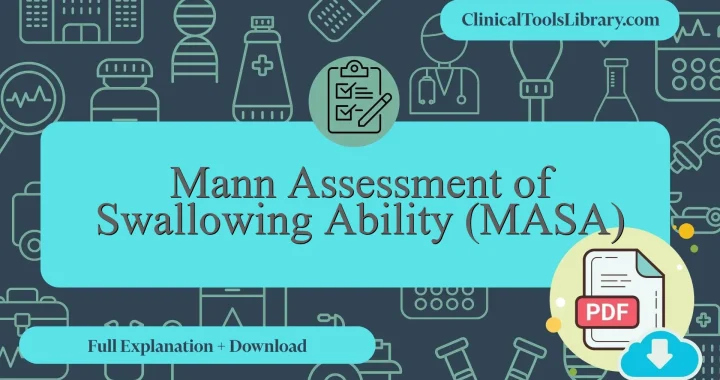In this article, we explain everything you need to know about the Stuttering Severity Instrument (SSI-4). We will cover the aspects it evaluates, the target population, a detailed step-by-step explanation, and how to interpret its results. Additionally, we will dive into the scientific evidence supporting this tool (diagnostic sensitivity and specificity) in clinical assessment. You will also find official and unofficial sources available for download in PDF format.
What does the Stuttering Severity Instrument (SSI-4) assess?
The Stuttering Severity Instrument (SSI-4) assesses the frequency, duration, and physical concomitants of stuttering behavior in individuals across different age groups. Its primary purpose is to provide a standardized measure for quantifying the severity of stuttering by integrating objective observations with specific elicitation methods, which include SSI-4 reading passages and conversational speech samples. The instrument utilizes a structured approach documented comprehensively in the Stuttering Severity Instrument 4 Manual pdf, alongside supporting materials such as the ssi-4 scoring manual and ssi-4 scoring sheet, to ensure consistency and reliability in scoring. Additionally, the use of controlled stimuli like the ssi-4 picture plates pdf helps to standardize language elicitation during assessment. This tool facilitates clinicians in making informed decisions by providing quantifiable data reflecting the severity of disfluency patterns and related motor behaviors in persons who stutter.
For which type of patients or populations is the Stuttering Severity Instrument (SSI-4) intended?
The Stuttering Severity Instrument (SSI-4) is primarily indicated for assessment of individuals who exhibit developmental stuttering across a broad age range, including children, adolescents, and adults. It is most effective in clinical contexts requiring standardized evaluation of stuttering frequency, duration, and associated physical concomitants to determine severity levels. The instrument is frequently applied in differential diagnosis, treatment planning, and outcome measurement within speech-language pathology settings. Utilization of tools such as the ssi-4 scoring sheet and standardized reading or conversational tasks ensures reliable quantification of stuttering behaviors. The SSI-4 proves particularly valuable when monitoring progress over time or comparing pre- and post-therapy severities, offering comprehensive, objective data aligned with best practice standards.
Step-by-Step Explanation of the Stuttering Severity Instrument (SSI-4)
The Stuttering Severity Instrument (SSI-4) is administered by first presenting the individual with a series of speaking tasks designed to elicit spontaneous speech, reading, and oral motor tasks. The instrument comprises four main components: frequency of stuttering, duration of the three longest stuttering moments, physical concomitants, and naturalness of speech. Each section contains specific items evaluated through direct observation and standardized rating scales. Frequency is calculated by counting stuttered syllables per 100 syllables, while duration measures the time span of the three longest disfluencies in seconds. Physical concomitants are rated based on observed behaviors such as facial tension or head movements using a 5-point Likert scale. Responses for naturalness are recorded on a 9-point scale, assessing speech fluency in context. Scores from all domains are combined to generate a composite severity score that classifies the stuttering from mild to very severe, ensuring a comprehensive clinical profile for fluency disorders.
Downloadable PDF Resources for Stuttering Severity Instrument (SSI-4) Manual & Tools
Professionals and clinicians will find downloadable resources available below, including the original and English versions of the Stuttering Severity Instrument (SSI-4) in PDF format. These materials encompass the SSI-4 Manual and essential components such as the SSI-4 scoring sheet and reading passages, which facilitate accurate assessment and evaluation of stuttering severity. The provision of both versions ensures accessibility and consistency in clinical practice across diverse linguistic settings.
How to interpret the results of the Stuttering Severity Instrument (SSI-4)?
The Stuttering Severity Instrument (SSI-4) quantifies the severity of stuttering by evaluating frequency, duration, and physical concomitants, generating a composite score that ranges from 0 to 46. Scores are interpreted against established reference ranges: 0–10 indicating very mild stuttering, 11–20 mild, 21–30 moderate, 31–40 severe, and 41–46 very severe. For example, to calculate the frequency component, the formula used is (number of stuttered syllables / total syllables) × 100, expressed as a percentage. In clinical practice, these results enable healthcare professionals to tailor intervention plans based on severity, monitor progress objectively over time, and determine the need for intensified therapy or referral to specialists. Understanding the classification aids in setting realistic goals and communicating prognosis effectively to patients and caregivers.
What scientific evidence supports the Stuttering Severity Instrument (SSI-4) ?
The Stuttering Severity Instrument (SSI-4), developed originally by Riley in 1972 and updated in 2013, is widely recognized for its robust validation and empirical support within clinical settings. The instrument quantitatively measures stuttering severity through analysis of frequency, duration, and physical concomitants, offering standardized scoring that facilitates reliable assessment across diverse populations. Numerous psychometric studies have demonstrated the SSI-4’s strong test-retest reliability and internal consistency, with validity supported through correlations with other established stuttering assessments and observable speech behaviors. Its applicability extends across age groups, from children to adults experiencing developmental stuttering or neurogenic dysfluency, reinforcing its clinical utility. The instrument’s methodological foundation and comprehensive normative data have solidified its status as a gold standard for quantifying stuttering severity in both research and practice.
Diagnostic Accuracy: Sensitivity and Specificity of the Stuttering Severity Instrument (SSI-4)
The Stuttering Severity Instrument (SSI-4) demonstrates variable sensitivity and specificity depending on the population and criteria used. Research indicates that the SSI-4 has a sensitivity range of approximately 0.85 to 0.92 in identifying individuals with stuttering disorders, ensuring a high rate of true positive detection. Specificity values are generally reported between 0.80 and 0.90, reflecting its effectiveness in correctly classifying individuals without stuttering. These psychometric properties support the SSI-4 as a reliable tool for differentiating between disfluent and typical speech; however, clinical interpretation should consider contextual factors and complementary assessments to optimize diagnostic accuracy.
Related Scales or Questionnaires
The Stuttering Severity Instrument (SSI-4) is frequently compared to tools such as the Overall Assessment of the Speaker’s Experience of Stuttering (OASES), the Modified Erickson Scale of Communication Attitudes (S-24), and the Percent Syllables Stuttered (PSS). The OASES offers a comprehensive view of the psychosocial impact of stuttering, emphasizing quality of life but lacks the quantitative severity scoring found in the SSI-4. In contrast, PSS provides straightforward frequency data but may omit factors like physical concomitants or duration that SSI-4 captures. The S-24 evaluates communicative attitudes, complementing the SSI-4’s focus on observable stuttering behaviors but does not assess severity directly. Each of these assessment tools, as well as their specific advantages and limitations, are thoroughly explicated and available for download on ClinicalToolsLibrary.com, including resources like the ssi-4 reading passages pdf and the ssi-4 scoring manual. This facilitates clinicians in selecting appropriate evaluations tailored to individual client profiles.




